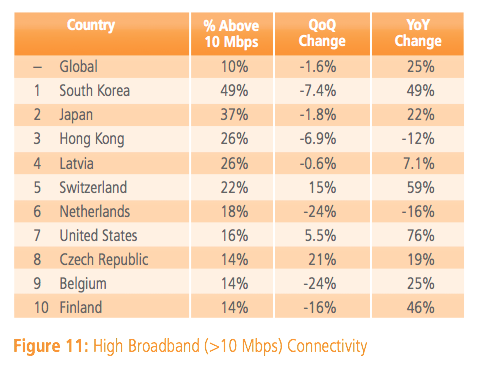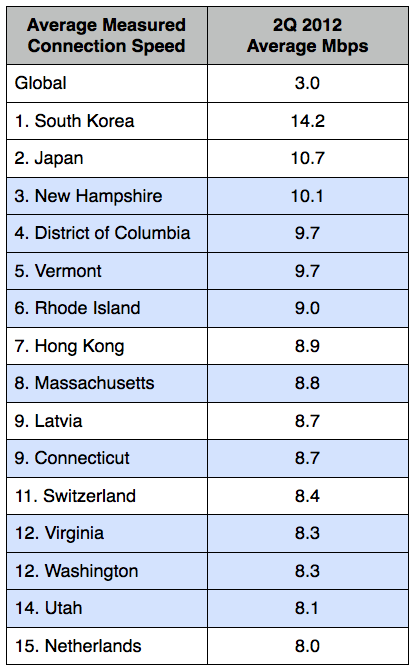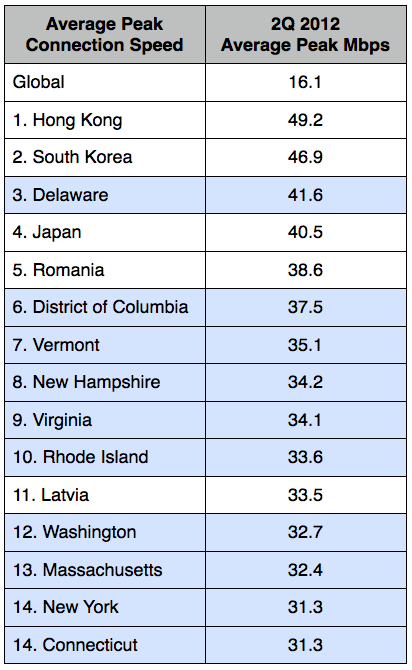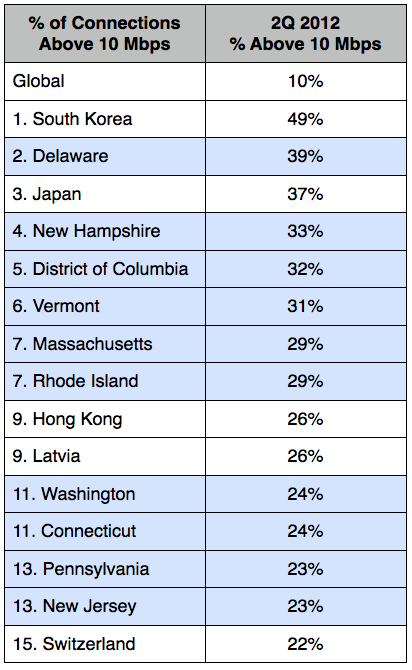Several years ago, some American lawyers and policymakers were looking for ways to boost government control of the Internet. So they launched a campaign to portray U.S. broadband as a pathetic patchwork of tin-cans-and-strings from the 1950s. The implication was that broadband could use a good bit of government “help.”
They initially had some success with a gullible press. The favorite tools were several reports that measured, nation by nation, the number of broadband connections per 100 inhabitants. The U.S. emerged from these reports looking very mediocre. How many times did we read, “The U.S. is 16th in the world in broadband”? Upon inspection, however, the reports weren’t very useful. Among other problems, they were better at measuring household size than broadband health. America, with its larger households, would naturally have fewer residential broadband subscriptions (not broadband users) than nations with smaller households (and thus more households per capita). And as the Phoenix Center demonstrated, rather hilariously, if the U.S. and other nations achieved 100% residential broadband penetration, America would actually fall to 20th from 15th.
In the fall of 2009, a voluminous report from Harvard’s Berkman Center tried to stitch the supposedly ominous global evidence into a case-closed indictment of U.S. broadband. The Berkman report, however, was a complete bust (see, for example, these thorough critiques: 1, 2, and 3 as well as my brief summary analysis).
Berkman’s statistical analyses had failed on their own terms. Yet it was still important to think about the broadband economy in a larger context. We asked the question, how could U.S. broadband be so backward if so much of the world’s innovation in broadband content, services, and devices was happening here?
To name just a few: cloud computing, YouTube, Twitter, Facebook, Netflix, iPhone, Android, ebooks, app stores, iPad. We also showed that the U.S. generates around 60% more network traffic per capita and per Internet user than Western Europe, the supposed world broadband leader. The examples multiply by the day. As FCC chairman Julius Genachowski likes to remind us, the U.S. now has more 4G LTE wireless subscribers than the rest of the world combined.
Yet here comes a new book with the same general thrust — that the structure of the U.S. communications market is delivering poor information services to American consumers. In several new commentaries summarizing the forthcoming book’s arguments, author Susan Crawford’s key assertion is that U.S. broadband is slow. It’s so bad, she thinks broadband should be a government utility. But is U.S. broadband slow?
According to actual network throughput measured by Akamai, the world’s largest content delivery network, the U.S. ranks in the top ten or 15 across a range of bandwidth metrics. It is ninth in average connection speed, for instance, and 13th in average peak speed. Looking at proportions of populations who enjoy speeds above a certain threshold, Akamai finds the U.S. is seventh in the percentage of connections exceeding 10 megabits per second (Mbps) and 13th in the percentage exceeding 4 Mbps. (See the State of the Internet report, 2Q 2012.)
You may not be impressed with rankings of seventh or 13th. But did you look at the top nations on the list? Hong Kong, South Korea, Latvia, Switzerland, the Netherlands, Japan, etc.
Each one of them is a relatively small, densely populated country. The national rankings are largely artifacts of geography and the size of the jurisdictions observed. Small nations with high population densities fare well. It is far more economical to build high-speed communications links in cities and other relatively dense populations. Accounting for this size factor, the U.S. actually looks amazingly good. Only Canada comes close to the U.S. among geographically larger nations.
But let’s look even further into the data. Akamai also supplies speeds for individual U.S. states. If we merge the tables of nations and states, the U.S. begins to look not like a broadband backwater or even a middling performer but an overwhelming success. Here are the two sets of Akamai data combined into tables that directly compare the successful small nations with their more natural counterparts, the U.S. states (shaded in blue).
Average Broadband Connection Speed — Nine of the top 15 entities are U.S. states.
Average Peak Connection Speed — Ten of the top 15 entities are U.S. states.
Percent of Connections Over 10 Megabits per Second — Ten of the top 15 entities are U.S. states.
Percent of Connections Over 4 Megabits per Second — Ten of the top 16 entities are U.S. states.
Among the 61 ranked entities on these four measures of broadband speed, 39, or almost two-thirds, are U.S. states. American broadband is not “pitifully slow.” In fact, if we were to summarize U.S. broadband, we’d have to say, compared to the rest of the world, it is very fast.
It is true that not every state or region in the U.S. enjoys top speeds. Yes, we need more, better, faster, wider coverage of wired and wireless broadband. In underserved neighborhoods as well as our already advanced areas. We need constant improvement both to accommodate today’s content and services and to drive tomorrow’s innovations. We should not, however, be making broad policy under the illusion that U.S. broadband, taken as a whole, is deficient. The quickest way to make U.S. broadband deficient is probably to enact policies that discourage investment and innovation — such as trying to turn a pretty successful and healthy industry that invests $60 billion a year into a government utility.
— Bret Swanson






